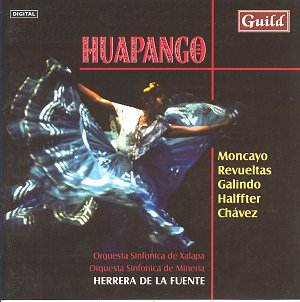HUAPANGO
Mexican Music
Pablo Garcia Josd Moncayo (1912-1958)
Huapango
Silvestre Revueltas (1899-1940)
Ocho X Radio
Bias Dimas Galindo (1910-1993) Sones de
Mariachi
Silvestre Revueltas
(1899-1940) Sensamaya
Rodolfo Halffter (1900-1987) Don Lindo de
Almena
Carlos Chavez (1899-1978) Sinfonia India
(Symphony No. 2)
Orquesta Sinfonica de Xalapa and Orquesta Sinfonica de Mineria conducted
by Herrera de la Fuente
Guild GMCD 7211 [58 mins]
Crotchet
AmazonUS

One of the greatest peculiarities of Britain's notorious musical insularity
is the neglect of the central and southern American repertoire, which doesn't
take itself so seriously as the usual symphony concert fare in this country.
The keynote is energy and a zest for life, and dance is never far away.
A brilliant South Bank Festival
¡VIVA!
in 1989 gave enormous pleasure to those who attended and was a critical success,
but audiences were small and it was embarrassing to be covering one unforgettable
concert at which a huge orchestra and massive choir, who had flown in for
this one event, far outnumbered the scattered listeners. I have indelible
memories of the Cuartetto Latinamericano (have they ever come back again?)
and of the conducting of Eduardo Mata, shortly before his untimely accidental
death.
These live performances recorded in 1981 & 1987 'with no equalisation
or limiting source' make for a good whistle-stop display of what we are missing.
Moncayo's Huapango is lively and joyful music, premiered in
August 1941 conducted by Carlos Chavez, whose Sinfonia India
(1935) is one of Mexico's best known orchestral works, with passages which
relate to Copland's idiom. Four movements played without pause, Sinfonia
India consists of a dance in 'scrambled rhythms', a gentle intermezzo,
a haunting slow section and a dance-rondo finale, complete with the prescribed
(optional!) stunning set of exotic tribal instruments deer hooves, clay rattle,
tlapanhuehuetl, teponaxtles & a string of butterfly
cocoons! Galindo was inspired by Jalisco on the southern Pacific
coast for his easy-going, sweet and sometimes a little sentimental Mariachi
Songs. Rodolfo Halffter (1900-1987), a pupil of Falla & uncle
of the avant-garde Cristobal Halffter, is of a neo-classical bent, and Stravinsky
comes to mind, but definitely in Mexican dress.
But the chief reason to add this to your collection may be the inclusion
of two works by the short-lived Silvestre Revueltas (1899-1940), far
and away the most individual of these composers, one whose originality is
always in evidence. Here there is the quirky, anarchic polytonal Eight
times radio for an odd assortment of eight instruments and
Sensemaya for a huge orchestra with lots of Latin & Indian instruments
to reinforce the 'small army of percussion'.
It is high time for another
¡VIVA!
festival - now that South Bank Centre is no longer a forbidding palace
of Classical Music, larger audiences might more easily be persuaded to join
the fun.
Peter Grahame Woolf

